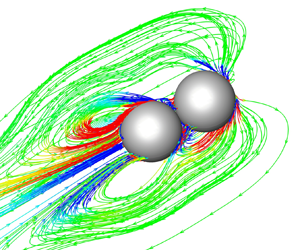Crossref Citations
This article has been cited by the following publications. This list is generated based on data provided by
Crossref.
Ye, Hao
Lin, Jianzhong
and
Ouyang, Zhenyu
2022.
The Hydrodynamics of a Rod-Shaped Squirmer near a Wall.
Processes,
Vol. 10,
Issue. 9,
p.
1841.
Gürbüz, Ali
Lemus, Andrew
Demir, Ebru
Pak, On Shun
and
Daddi-Moussa-Ider, Abdallah
2023.
The effect of axisymmetric confinement on propulsion of a three-sphere microswimmer.
Physics of Fluids,
Vol. 35,
Issue. 8,
Ouyang, Zhenyu
Lin, Zhaowu
Lin, Jianzhong
Yu, Zhaosheng
and
Phan-Thien, Nhan
2023.
Cargo carrying with an inertial squirmer in a Newtonian fluid.
Journal of Fluid Mechanics,
Vol. 959,
Issue. ,
Yang, Fu-Ling
Chen, You-An
Premlata, A.R.
and
Wei, Hsien-Hung
2023.
Stick-slip squirmers: slip asymmetry can qualitatively change self-swimming characteristics of squirmers.
Journal of Fluid Mechanics,
Vol. 967,
Issue. ,
Mo, Chaojie
Li, Gaojin
and
Bian, Xin
2023.
Challenges and attempts to make intelligent microswimmers.
Frontiers in Physics,
Vol. 11,
Issue. ,
Ouyang, Zhenyu
Lin, Zhaowu
Lin, Jianzhong
Phan-Thien, Nhan
and
Zhu, Jue
2023.
Swimming of an inertial squirmer and squirmer dumbbell through a viscoelastic fluid.
Journal of Fluid Mechanics,
Vol. 969,
Issue. ,
Ouyang, Zhenyu
Liu, Chen
Qi, Tingting
Lin, Jianzhong
and
Ku, Xiaoke
2023.
Locomotion of a micro-swimmer towing load through shear-dependent non-Newtonian fluids.
Physics of Fluids,
Vol. 35,
Issue. 1,
Zhang, Minkang
Yu, Zhaosheng
Xia, Yan
Ouyang, Zhenyu
Chen, Sheng
and
Lin, Zhaowu
2024.
Collective motions of microorganisms in geometric confinement.
Physics of Fluids,
Vol. 36,
Issue. 12,
Ouyang, Zhenyu
Liu, Chen
Lin, Zhaowu
and
Lin, Jianzhong
2024.
Modeling a spheroidal squirmer through a complex fluid.
Physical Review Fluids,
Vol. 9,
Issue. 7,
Lin, Zhaowu
Zhang, Minkang
Chen, Xingfan
Cheng, Xiaoliang
and
Yu, Zhaosheng
2024.
Hydrodynamic interactions between two microswimmers in viscoelastic fluids.
Physics of Fluids,
Vol. 36,
Issue. 8,
Ouyang, Zhen-yu
and
Lin, Jian-zhong
2024.
Recent progress in self-propelled particles.
Journal of Hydrodynamics,
Vol. 36,
Issue. 1,
p.
61.
Zhang, Minkang
Yu, Zhaosheng
Ouyang, Zhenyu
Xia, Yan
and
Lin, Zhaowu
2024.
Numerical study of collective motion of microswimmers in Giesekus viscoelastic fluids.
Journal of Non-Newtonian Fluid Mechanics,
Vol. 329,
Issue. ,
p.
105245.
Mishra, Rishish
Gosika, Mounika
Gidituri, Harinadha
and
Pothukuchi, Harish
2024.
Flow structure around a microswimmer at fluid–fluid interface.
Fluid Dynamics Research,
Vol. 56,
Issue. 4,
p.
045507.
Xu, Jianbao
Ouyang, Zhenyu
Lin, Jianzhong
and
Nie, Deming
2024.
Modeling the hydrodynamic interaction of two chiral organisms.
Physics of Fluids,
Vol. 36,
Issue. 9,
Xu, Jianbao
Ouyang, Zhenyu
and
Lin, Jianzhong
2024.
Hydrodynamic behavior of Janus particles in a finite inertial flow.
Fluid Dynamics Research,
Vol. 56,
Issue. 3,
p.
035507.
Ishikawa, Takuji
2024.
Fluid Dynamics of Squirmers and Ciliated Microorganisms.
Annual Review of Fluid Mechanics,
Vol. 56,
Issue. 1,
p.
119.
Jiang, Tongxiao
Nie, Deming
and
Lin, Jianzhong
2024.
Swimming velocity of spherical squirmers in a square tube at finite fluid inertia.
Applied Mathematics and Mechanics,
Vol. 45,
Issue. 9,
p.
1481.
Zheng 郑, Kai-Xuan 凯选
Wang 汪, Jing-Wen 静文
Wang 王, Shi-Feng 世锋
and
Nie 聂, De-Ming 德明
2024.
Passive particles driven by self-propelled particle: The wake effect.
Chinese Physics B,
Vol. 33,
Issue. 4,
p.
044501.
Xia, Yan
Yu, Zhaosheng
Lin, Jianzhong
Lin, Zhaowu
and
Hu, Xiao
2025.
Dynamics of a spheroidal squirmer interacting with a cylindrical obstacle.
Soft Matter,
Ouyang, Zhenyu
Li, Gaojin
Lin, Zhaowu
Lin, Jianzhong
and
Yu, Zhaosheng
2025.
Transport characteristics of finite-size microorganisms in turbulent channel flows.
Journal of Fluid Mechanics,
Vol. 1007,
Issue. ,
